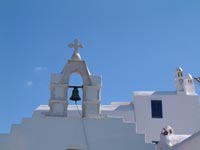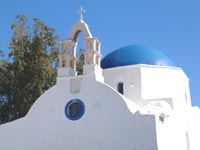| Greece > Tourism > Cyclades > Mykonos > Mykonos Island Information | ||||
| Mykonos Island |
|
|||
Mykonos Travel Information - Holidays in Mykonos Sightseeing, Museums, Beaches, History of Mykonos Greece
Mykonos Island – Holidays in GreeceFed up of everyday life? Do you want to forget everything? Want to have a bash? Want to soak sun & sand? Then Mykonos is the place to be.Mykonos Island (often called the Jewel of the Aegean Sea) is a Greek island in the middle of the vast Aegean Sea. A quick search in Google for Mykonos indicates that some people spell it as Myconos, Mikonos, Miconos or even Mycanos. It is one of the most cosmopolitan among the Cyclades group of islands. Famed for its night life, pristine beaches, blue sky, deep blue sea, windmills, unique Cycladic architecture, pubs, bars, gay clubs, Greek cuisine, ouzo, picturesque fishing villages, friendly locals and many more things, Mykonos is one of the top tourist destinations in Europe with many Greek and European stars frequenting its beach bars and restaurants. Whether you are looking for sun & sand, birding, surfing, jet skiing, romance, snorkelling, bars and clubs with famous DJs or anything, Mykonos is the place to be with your loved ones. Getting to Mykonos Mykonos is a well connected place. Catamaran services and ferries go to Mykonos daily from Piraeus and Paros. It costs around 25 Euro. Mykonos can also be reached from Santorini. Mykonos is also connected by air. Flights take off from Santorini, Athens and Thessaloniki. During peak season some flights operate directly from Εurope to Mykonos. Getting Around In Mykonos getting around is fairly easy. There are scooters, cars and ATV available. The entire island is connected by bus service and taxis are also available. Places or Things to See Whitewashed ancient Greek windmills (Kato Milli) are a must see. Most of the houses here are built in Cycladic architecture. Some ancient monuments in Drafaki, Vrissi, Glastros, Platis Yialos. Paraportiani Church in Kastro. Little Venice is a district in Chora famous for its flowered and colorful balconies. The Zoodoxos Pigi Cathedral (Mitropoli), Panachra, Agia Kyriaki, Agios Nikolaos (Post-Byzantine Era Churches) are popular with sightseers. Kalafati Divonia bay and Panormos Ftelia should be included in your sightseeing tour. Monasteries like the Monastery of Virgin Mary of Tourliani, Monastery of Paleokastro, 17th century church of Panagia Lozaria in Alefkandra square and the historical monuments in Marathi and Ampelokipos. "Tria Pigadia" or the three wells and the 17th century neoclassical town hall are famous tourist attractions, as well. Do not miss paying a visit at Mykonos museums, such as the Archaeological Museum, the Folk Museum and the Aegean Naval Museum that countless visitors admire every year. Finally, Petros the pelican is an immensely popular pelican with the tourists. Places to Stay There is a plethora of good hotels in Mykonos which offer comfortable and modern facilities, great food and exquisite sea view. Mykonos is hot during July and August so it is better to book air-conditioned hotels in those months. The Beaches in Mykonos Mykonos boasts a plethora of wonderful beaches, with amazing crystal clear waters and golden sands, addressing to various crowds with different preferences. Whether you find yourselves in Mykonos with family or friends, whether you are straight or gay, whether you prefer nudism or you are a beach bar fan, Mykonos has for sure the type of beach that you will adore. Places to Eat and Drink in Mykonos In Mykonos town, there are plenty of good places to eat In a relaxing atmosphere. There are several traditional restaurants in Ano Mera, while there are plenty of clubs and bars scattered throughout the island, where you can enjoy wonderful cocktails. Cuisine Greek cuisine is typically Mediterranean. The basic grains are barley and wheat. Olive oil gives a distinctive taste to Greek food. The appetizers here are called Meze and are served with Ouzo. There are many popular dishes that you may try in Greece. Moussaka is eggplant casserole. There are some variations in Moussaka like zucchini or rice. Kleftiko is marinated lamb in garlic and lemon juice slow baked to the bone. Souvlaki is lamb and vegetable grilled on skewers. Gyros is roasted meat served with sauce and garnishes. Boureki and Pastitsio are other popular dishes. There are some popular desserts to taste, too. Baklava is pastry with nuts, honey syrup etc. Ghalaktoboureko is custard pastry. Loukoumades and Loukoumia are other popular sweets. Drinks Ouzo is the national drink. A must try for first time visitors to Greece. It is an alcoholic beverage flavored with Anise. It turns milky white when mixed with water. Tsipouro is a home brewed drink similar to Raki. Metaxa is a sweet brandy. Mavrodafni is sweet red wine. Retsina is white wine with pine tar. Beer and wine are widely consumed in Greece. Teetotalers can taste Greek coffee. Greek coffee is made by boiling finely ground beans. It is often sweetened and is served thick. Mykonians The population of the island is about 6200. The economy is mainly dependent on tourism. The locals understand English and are used to tourists, nude beaches and gay clubs etc. They are friendly, kind, discreet and open people and know how to have fun. In order to book accommodation, travel tickets, organise excursions on the island etc, contact Mykonos travel agencies which will cater for your vacation to the last detail. Mykonos Island HistoryThe island took its name from "Mykonos", the son of the mythical king of Delos Anios, who was a descendant of the god Apollo and the nymph Rio. According to Greek mythology, Zeus (literally the father in the sky) defeated the Gigantes (the ancient Giants who had rosen against the Olympians) on Mykonos Island. The Giants were buried under the Mykonos granite by Hercules. Little is known about Mykonos during the ancient times but according to coin descriptions, we are able to presume that Dionysus was the patron god of the island. Phoenicians were the first inhabitants of the island. Later it was ruled by Persian generals, then Romans ruled Mykonos for some time, subsequently the Byzantines occupied Mykonos. By 1207 it was under the occupation of the Venetians and was totally destroyed and deserted. In 1537 it was attacked by Admiral Barbarossa, after which it came under the rule of the Ottomans. The Mykonians were proved to be very experienced sailors and decisively contributed to the war of Independence of 1821 with their ships, while the most important figure in the set-up and funding of the fight was the Mykonian heroine Manto Mavrogenous, thanks to whom the Turks who tried to disembark on the island on October 1822 were blocked. Finally, Greek immigrants came to the islands and it later came under Greek rule. Mykonians are famed sailors and a colourful flotilla can be seen at the waterfront in Hora (the main town of Mykonos). Many people say you have not seen Greece till you have seen Mykonos. During 1933 the first tourists appear, who mostly visit the archaeological site on the sacred island of Delos and the Museum of Mykonos, while around the mid fifties, Mykonos is beginning to transform to the cosmopolitan tourist resort of recent years, attracting visitors from all over the globe. Mykonos has an area of 86 km² and an elevation of 364 m. It is made mostly of granite and has little water. There are approximately 6200 inhabitants. The largest town is Mykonos, also known as Hora, the capital town of the island, on the west coast. |
||
| Mykonos Nightlife & Entertainment | Mykonos Sightseeing | Mykonos Information | Mykonos Museums |
| Surrounding Islands | Mykonos Beaches | Mykonos Travel Info Greece |
| Mykonos Weather | Mykonos Photo Gallery Greece | Mykonos Greece |
| Hotels in Mykonos | Luxury Hotels | Apartment Hotels | Suites | Apartments | Studios | Honeymoon | Mykonos Vacations |
| Mykonos Greece | Mykonos Island | Mykonos Holidays| Beach Hotels |
| Cyclades Islands | Tourism | United Hellas Home Page |
| Hotels - Apartments - Suites throughout Greece | Car Rentals throughout Greece |
| Travel Agencies throughout Greece | Cruises & Sailing Yacht Charters in Greece |

